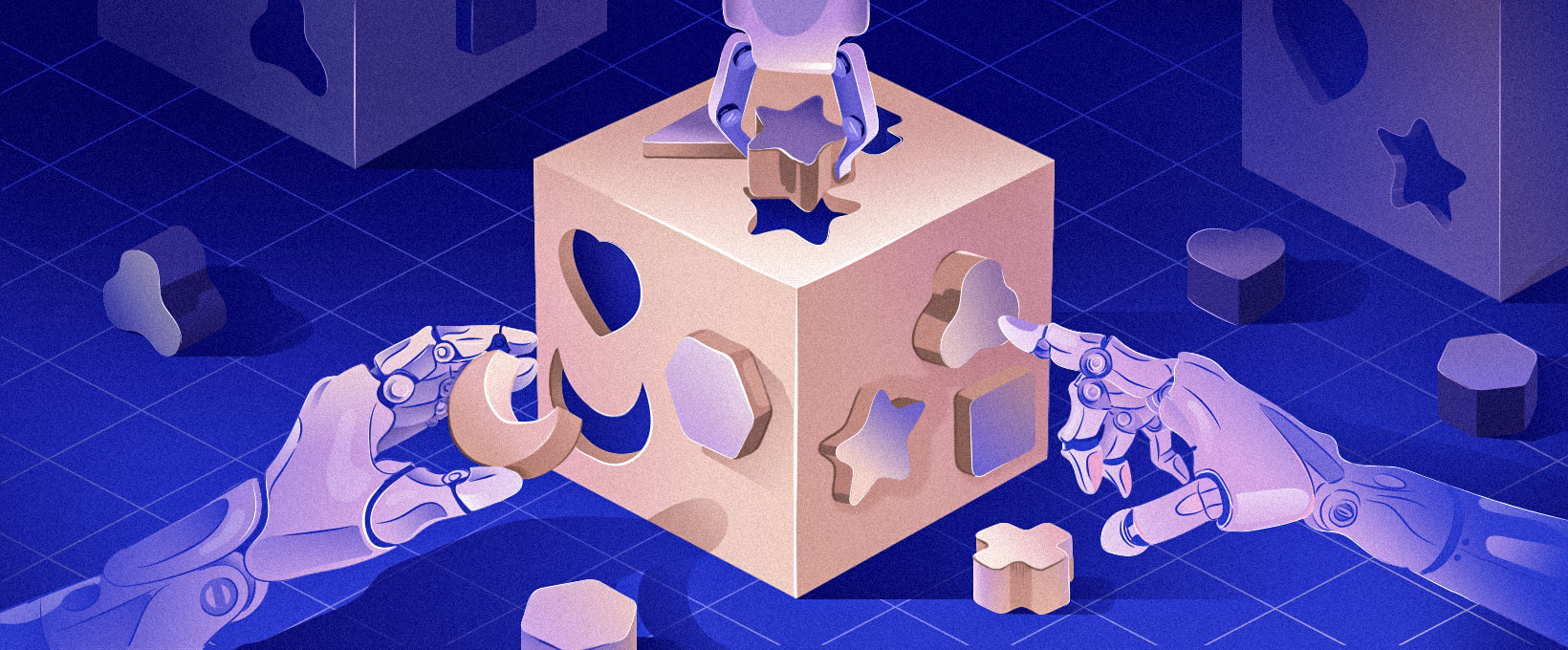- Custom Enterprise Software Landscape of Today
- Rationales for Launching Enterprise Software Development Projects
- How Enterprise Software Development Services Are Provided: Workflows
- Trends in Enterprise Software Solutions Worth Highlighting
- Weighty Reasons to Choose Us As Your Enterprise Software Development Partner
An abstract understanding of enterprise software may seem straightforward on the surface. However, delving into its practical intricacies and bringing them together within a coherent framework proves far more challenging. Essentially, when we speak of enterprise software development, we refer to solutions designed to meet the collective needs of organizations as large-scale entities, rather than serving individual, task-focused departments with narrowly defined scopes of work.
This broad, and at times somewhat vague, category of software solutions encompasses versatile functions, e.g., project management, business intelligence, CRM systems, enterprise resource planning, content management, etc. The mission of enterprise software solutions is to integrate these diverse facets seamlessly and comprehensively (or at least address several domains at once) so that all the individual ‘blocks’ continue to perform their functions while operating together in a coordinated, synchronized manner.
As such, this category of software solutions addresses pivotal requirements, encompassing centralized data management, information exchange, and workflow optimization. In light of such tasks, it is no surprise that the market for enterprise software is enormous. For the year 2025 alone, per Statista as of November 2025, this segment is projected to amass a revenue of almost $317 billion. Their further estimates indicate that it will hit almost $404 billion around 2030.
Custom Enterprise Software Landscape of Today
As an experienced custom enterprise software development company, Andersen prefers to begin such discussions with a general overview. Our goal is to pin down what is in demand now and to speculate on what the future software development trends are likely to be.
Custom enterprise solutions, as defined by Techopedia, are suites specifically tailored for organizational use, serving as collections of business-oriented tools. There are various ways to classify them. Statista, for instance, outlines the primary types of enterprise software as follows:
- Software for content management activities;
- Tools for eCommerce businesses;
- ERP suites;
- Supply chain management software;
- BI options;
- CRM systems;
- Enterprise performance management software, etc.

What unites today’s enterprise solutions? Which core characteristics do they share? In our view, as a custom software development company, the answer lies in how these products are envisioned, built, refined, and maintained. In essence, custom enterprise software engineering should be guided by the following key principles:
#1. Resilience. The ability to operate reliably and effectively during critical moments and under challenging conditions. This includes, but is not limited to, natural disasters, economic crises, and other major disruptions.
#2. Scalability. The capacity to grow with your organization. Truly scalable solutions are capable of accommodating rising user demands, expanding data volumes, new functions, and a larger number of end-users.
#3. Manageability. The ease with which the software can be used, maintained, and tested cost-effectively.
#4. Digital safeguards in place. The security measures implemented by your enterprise software vendor to protect sensitive data, including personal and business information.
#5. Multifunctionality. The software’s ability to perform multiple diverse tasks concurrently.
Having covered these introductory details, let's now delve into why choosing custom enterprise software is preferable. It is time to examine the difference between custom software vs off-the-shelf software solutions.
Interesting fact: per GoodFirms, nearly 85% of software development teams deal with enterprise applications
Rationales for Launching Enterprise Software Development Projects
Speaking of the relative pros and cons we would start with the second part of the equation. As a company offering enterprise software development solutions, we do admit that our “one-size-fits-all” counterparts offer some pros:
-
A range of more or less transparent and publicly available pricing plans are instantly visible, with clear and well-explained packages;
-
Such ready-made enterprise suites can be swiftly implemented and deployed;
-
You are free to explore customer reviews, feedback, references, and even social media sentiment before making decisions to purchase anything;
-
Typically, free trial options are within reach (sometimes, with curtailed functionalities);
-
Support is offered, and regular upgrades take place steadily, without your intervention.
Concurrently, the advantages presented by generic tools pale when contrasted with custom software development benefits. Here are the factors that outweigh them, in our eyes:
-
To begin with, tailor-made code will precisely align with your distinct corporate requirements;
-
Second, collaborating with an enterprise-grade development vendor ensures access to comprehensive and industry-best security measures, all matching your concerns;
-
You can arrange for extended maintenance packages beforehand on top of development;
-
The factor of exclusive ownership and complete control, devoid of licensing concerns or other complications, also shines in custom development contexts;
-
Advanced integration possibilities, seamlessly connecting your custom enterprise suite with any third-party program of choice and importance;
-
Dedicated teams for quality assurance, onboarding, and training requirements.
Considering the aforementioned factors, it becomes evident that for companies engaged in intricate operations, opting for a custom approach proves advantageous. Despite potential additional expenses, the resultant boost in deliverables is undeniable. Consequently, your enterprise will emerge as more competitive, agile, and robust.
How Enterprise Software Development Services Are Provided: Workflows
At Andersen, we normally stick to these four phases, even though your exact enterprise software development process might differ, depending on your particular one-of-a-kind circumstances.
Custom development phase #1: project discovery
Thorough business analysis serves as a fundamental prerequisite for achieving eventual development successes. During this stage, we meticulously assess your industry niche, competitors, corporate objectives, tech-specific limitations, practiced workflows, and preferences. At Andersen, our primary focus lies in gathering comprehensive information to craft something that precisely aligns with your expectations and needs.
In addition to this, we create detailed requirement specifications, functionality outlines, project scopes, roadmaps, and dependable development estimates. Furthermore, we assemble teams equipped with the requisite skills and technology stacks.
Custom development phase #2: UI/UX design and QA
Customer experiences are what makes custom enterprise software worth its price tag. Both ends must be considered, i.e. your client’s target audience, on the one hand, and their staff members, on the other hand. Thus, your controls and panels need to be sufficiently extensive to perform all necessary tasks. Simultaneously, they also should be intuitive, logical, easily navigable, and comprehensible.
At Andersen, we undertake comprehensive responsibility for every aspect of your user experience, from mapping out user journeys to crafting actionable prototypes. Our meticulous attention to detail encompasses every element, down to each individual button and window within your interface. Once the designs are finalized, we conduct thorough testing with relevant user groups to pinpoint any potential bottlenecks or errors.
This iterative process ensures that your product not only meets but exceeds user expectations, delivering a seamless and intuitive experience at every interaction point.
Custom development phase #3: engineering
It's time to advance into the development phase. Building upon the technological specifications and architectural vision outlined in phase one, we initiate the Agile development process. Operating as a lean enterprise software development team, we ensure a streamlined process structured into concise yet impactful iterations:
-
Development planning;
-
Development sprint;
-
Feedback on development outcomes;
-
Analysis;
-
Next iteration.
Custom development phase #4: QA, deployment, handover, ongoing support and maintenance
Ultimately, the solution delivered by us undergoes rigorous testing procedures (on top of limited QA rounds held within our Agile framework), is deployed, and then transferred to the customer.
Andersen's team stands prepared to take on ongoing support and maintenance as required. In the event of any issues, necessary improvements are promptly implemented.
Trends in Enterprise Software Solutions Worth Highlighting
Andersen’s enterprise application software team is ever-ready to unleash the potential of the cutting-edge and most promising enterprise software trends. These comprise a range of groundbreaking and game-changing technologies.
- To name some, we could apply AI and ML power to your systems. As a result, you will benefit from:
-
Big Data-based insights and more productive business patterns;
-
Artificial intelligence can also help you with error testing and solving security issues, e.g. data breaches and hacking attempts, etc.;
-
Smart, self-learning, and adaptable RPA tools enable the automation of repetitive and rule-based tasks by simulating human interactions with software systems. Such solutions could assume responsibility for such work aspects as, say, inputting data, processing invoices, generating reports, executing daily workflows, and extracting information.
-
Augmented Reality (AR) and Virtual Reality (VR) platforms are increasingly popular as numerous businesses fuse them with enterprise software applications. Industries such as industrial manufacturing, healthcare businesses, retail giants, and more are harnessing AR and VR capabilities to deliver effective training, hands-on sessions, and immersive experiences.
-
Furthermore, Andersen consistently delivers cutting-edge IoT products to manufacturing enterprises and logistics companies. These leverage technologies proficient in gathering essential data from every equipment piece, device, or gadget. As a result, you'll have the ability to monitor all events and advancements, empowering real-time data-driven decision-making.
-
Blockchain. While not a particularly new phenomenon, blockchain is still a promising direction to explore. Peer-to-peer (P2P) networks offer greater transparency, effective decentralization, and advanced distributed ledger capabilities, together with enhanced security features.
-
Cloud computing. Utilization of cloud-based services, platforms, and infrastructure by businesses to store, manage, and process heterogeneous data paves a path toward boosted business capacity, improved collaboration, and greater focus on core activities.
According to a survey cited by GoodFirms, these top-5 domains are recognized as being the most sought-after in the tech community:
- AI with almost 70%;
- Blockchain with 56%;
- IoT with 47%;
- Big Data with 31%;
- Cloud with around 29%;
- AR/VR with roughly 27%.
Finally, we excel in building complex yet robust microservice-based architectures, offering seamless pathways for scaling up your solutions. Through our innovative approach, Andersen ensures that your technological infrastructure not only meets but exceeds the demands of modern enterprise operations.
Weighty Reasons to Choose Us As Your Enterprise Software Development Partner
As a provider of custom software development services, Andersen offers a range of compelling advantages. Here are some figures and facts to substantiate this claim:
- Our successful 17-year track record of technological excellence, strategic collaborations, and gradual growth;
- Over 1000 implemented IT initiatives in our portfolio, showcasing our profound expertise in terms of project planning, engineering, integration services, QA, you name it.
- Serving more than 90 enterprise-grade customers;
- Rated 4.9 out of 5 on Clutch.co;
- 64% long term engagements.
From tech consulting, web-based engineering, and mobile app development to integration, migration, and legacy-specific needs, we are well-equipped to handle end-to-end solutions. Whatever your current enterprise-grade plans, ambitions, or challenges might be,
Andersen’s team of technology experts stands ready to assist your organization as a dependable, top-ranked, and trusted enterprise software development company. Our skilled and knowledgeable Business Analysts, Project Managers, developers, and professional testing specialists will strive to exceed your expectations, whether they’re project planning activities, implementation, or quality assurance.
What our custom enterprise software company offers—and delivers day-by-day—are transparent workflows executed through coordinated joint efforts and focused on tangible results. Contact us to achieve your objectives on time and within budget by obtaining a high-performing and protected custom solution.
We will guide you through every phase, drawing from our extensive experience in executing numerous challenging initiatives across a variety of sectors.





